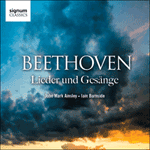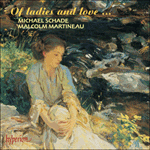
Welcome to Hyperion Records, a British classical label devoted to presenting high-quality recordings of music of all styles and from all periods from the twelfth century to the twenty-first.
Hyperion offers both CDs, and downloads in a number of formats. The site is also available in several languages.
Please use the dropdown buttons to set your preferred options, or use the checkbox to accept the defaults.

The main problem appears to have been the piano part. With the benefit of hindsight it may appear innocent enough, especially when set beside those by, say, Rachmaninov; yet at the time, the solo-sonata style Beethoven adopts for the third verse in particular was perceived as overbalancing the text.
Similarly the dramatic outpourings of that same verse, with its sudden changes of dynamic and the Mozartian Allegro molto final verse, were considered more suited to the opera house than the drawing room. This uncharacteristic outburst of theatricals may have been inspired by Beethoven’s studies with opera maestro Salieri (the legendary Mozart poisoner), although the songs of his old teacher, Christian Neefe (1748-1798), also leant in this direction.
from notes by Julian Haylock © 1999
A l’identique, les effusions dramatiques de cette même strophe, avec ses brusques changements de dynamique et son dernier vers à l’Allegro molto mozartien, furent considérées comme davantage adaptées à l’opéra qu’au salon. Beethoven a pu concevoir cette insolite explosion d’effets théâtraux en se rappelant ses études auprès du maestro d’opéra Salieri (le légendaire empoisonneur de Mozart) – ou de son vieux maître, Christian Neefe (1748-1798), dont les lieder présentent cette même tendance.
extrait des notes rédigées par Julian Haylock © 1999
Français: Hyperion Records Ltd
Das Hauptproblem scheint der Klavierpart gewesen zu sein. Er mag aus heutiger Perspektive durchaus harmlos wirken, schon gar, wenn man ihn beispielsweise neben den von Rachmaninow stellt; damals jedoch wurde der Solosonatenstil, den Beethoven besonders in der dritten Strophe anwendet, dem Text gegenüber als zu gewichtig empfunden.
Ebenso fand man die dramatischen Ergüsse der besagten Strophe mit ihren plötzlichen Dynamikwechseln und die als Mozartsches Allegro molto angelegte letzte Strophe geeigneter fürs Opernhaus als für den Salon. Dieser untypische Ausbruch von Theatralik könnte durch Beethovens Unterricht bei dem Opernkomponisten Salieri inspiriert worden sein (dem nachgesagt wurde, er habe Mozart vergiftet), aber die Lieder seines alten Lehrers Christian Neefe (1748-1798) neigen ebenfalls in diese Richtung.
aus dem Begleittext von Julian Haylock © 1999
Deutsch: Anne Steeb/Bernd Müller
 Beethoven: Lieder und Gesänge Beethoven: Lieder und GesängeBeethoven was not a keen song writer, yet despite this almost half of his total works call for a voice. The present album includes some of the best of those compositions interpreted by accomplished tenor John Mark Ainsley and his accompanist Iain ...» More |
 Of ladies and love Of ladies and love‘This is singing which is always alive, interesting, and personal … a fascinating record’ (Gramophone) ‘[Schade] sings Strauss’s Cäcilie and a wonderfully hushed Zueignung as though he and Martineau were the first to discover their ecstasy ...» More |

